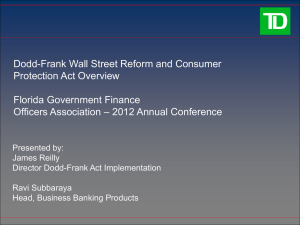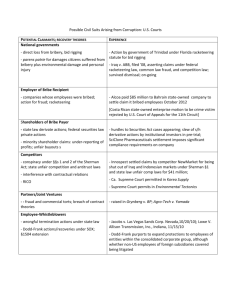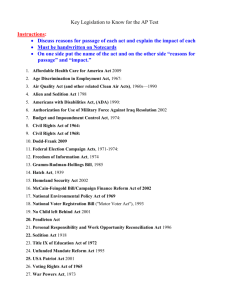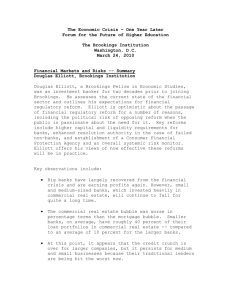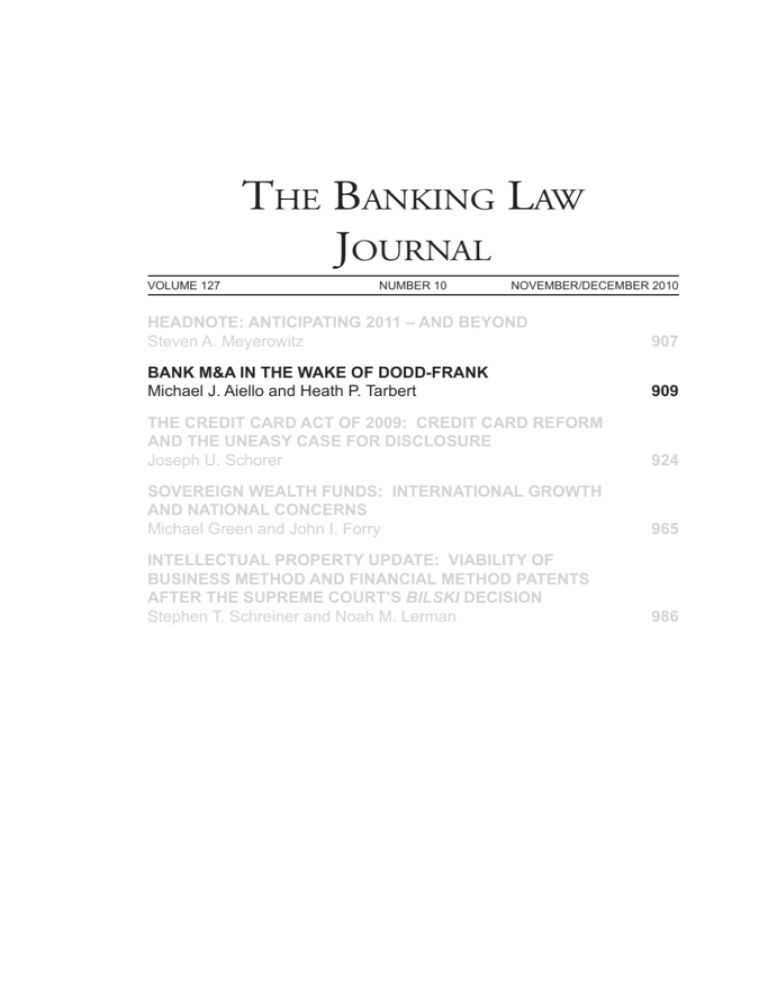
The Banking Law
Journal
Volume 127
Number 10
November/December 2010
Headnote: Anticipating 2011 – And Beyond
Steven A. Meyerowitz
907
Bank M&A in the Wake of Dodd-Frank
Michael J. Aiello and Heath P. Tarbert 909
The Credit CARD Act of 2009: Credit Card Reform
and the Uneasy Case for Disclosure
Joseph U. Schorer
924
Sovereign Wealth Funds: International Growth
and National Concerns
Michael Green and John I. Forry
965
intellectual Property Update: Viability of
Business Method and Financial Method Patents
After the Supreme Court’s Bilski Decision
Stephen T. Schreiner and Noah M. Lerman
986
Editor-in-chief
Steven A. Meyerowitz
President, Meyerowitz Communications Inc.
Board of Editors
Paul Barron
Professor of Law
Tulane Univ. School of Law
George Brandon
Partner, Squire, Sanders & Dempsey
LLP
Barkley Clark
Partner, Stinson Morrison Hecker
LLP
John F. Dolan
Professor of Law
Wayne State Univ. Law School
Stephanie E. Kalahurka
Hunton & Williams, LLP
Thomas J. Hall
Partner, Chadbourne & Parke LLP
Michael Hogan
Ashelford Management Serv. Ltd.
Mark Alan Kantor
Washington, D.C.
Satish M. Kini
Partner, Debevoise & Plimpton LLP
Paul L. Lee
Partner, Debevoise & Plimpton LLP
Jonathan R. Macey
Professor of Law
Yale Law School
Bankruptcy for Bankers
Howard Seife
Partner, Chadbourne & Parke LLP
Regional Banking Outlook
James F. Bauerle
Keevican Weiss Bauerle & Hirsch
LLC
Martin Mayer
The Brookings Institution
Directors’ Perspective
Christopher J. Zinski
Partner, Schiff Hardin LLP
Julia B. Strickland
Partner, Stroock & Stroock & Lavan
LLP
Banking Briefs
Donald R. Cassling
Partner, Quarles & Brady LLP
Marshall E. Tracht
Professor of Law
New York Law School
Intellectual Property
Stephen T. Schreiner
Partner, Goodwin Procter LLP
Stephen B. Weissman
Partner, Rivkin Radler LLP
Elizabeth C. Yen
Partner, Hudson Cook, LLP
The Banking Law Journal (ISSN 0005 5506) is published ten times a year by A.S. Pratt & Sons, 805 Fifteenth
Street, NW., Third Floor, Washington, DC 20005-2207. Application to mail at Periodicals postage rates is pending
at Washington, D.C. and at additional mailing offices. Copyright © 2010 ALEX eSOLUTIONS, INC. All rights
reserved. No part of this journal may be reproduced in any form — by microfilm, xerography, or otherwise — or
incorporated into any information retrieval system without the written permission of the copyright owner. Requests
to reproduce material contained in this publication should be addressed to A.S. Pratt & Sons, 805 Fifteenth Street,
NW., Third Floor, Washington, DC 20005-2207, fax: 703-528-1736. For subscription information and customer service, call 1-800-572-2797. Direct any editorial inquires and send any material for publication to Steven A.
Meyerowitz, Editor-in-Chief, Meyerowitz Communications Inc., 10 Crinkle Court, Northport, New York 11768,
SMeyerow@optonline.net, 631-261-9476 (phone), 631-261-3847 (fax). Material for publication is welcomed —
articles, decisions, or other items of interest to bankers, officers of financial institutions, and their attorneys. This
publication is designed to be accurate and authoritative, but neither the publisher nor the authors are rendering
legal, accounting, or other professional services in this publication. If legal or other expert advice is desired, retain the
services of an appropriate professional. The articles and columns reflect only the present considerations and views of
the authors and do not necessarily reflect those of the firms or organizations with which they are affiliated, any of the
former or present clients of the authors or their firms or organizations, or the editors or publisher.
POSTMASTER: Send address changes to The Banking Law Journal, A.S. Pratt & Sons, 805 Fifteenth Street, NW.,
Third Floor, Washington, DC 20005-2207.
Bank M&A in the Wake of Dodd-Frank
Michael J. Aiello and Heath P. Tarbert
Financial regulatory overhauls generally produce waves of mergers and acquisitions. Notwithstanding congressional intent, Dodd-Frank promises to be no different. This article examines Dodd-Frank’s key provisions governing bank M&A
transactions as well as those critical aspects of the legislation most likely to drive
future consolidation within the banking industry.
E
arlier this year, Congress enacted the most sweeping overhaul of U.S.
bank regulation in decades. Although the Dodd-Frank Wall Street
Reform and Consumer Protection Act1 (“Dodd-Frank” or the “Act”)
regulates a host of financial activities beyond the traditional banking sector,
the enhanced regulation of depository institutions and their holding companies is a central theme running throughout Dodd-Frank’s 2,300 pages.
Past as Prologue?
Legislative tsunamis are nothing new for the banking sector.2 Within the
last 30 years, a number of major pieces of federal legislation have fundamentally
changed the business of banking. The most prominent examples include the
Garn-St. Germain Act of 1982, the Riegle-Neal Act of 1994, and the GrammLeach-Bliley Act of 1999.3 Each successive regulatory overhaul has historically
Michael J. Aiello is co-head of the New York Private Equity and Mergers & Acquisitions Department of Weil, Gotshal & Manges LLP. He is also a member of the
firm’s Management Committee. Heath P. Tarbert is head of the Financial Regulatory Reform Working Group at Weil, Gotshal & Manges LLP. He previously served
as Special Counsel to the U.S. Senate Banking Committee. The authors can be
reached at michael.aiello@weil.com and heath.tarbert@weil.com, respectively.
909
Published in the November/December 2010 issue of The Banking Law Journal.
Copyright 2010 ALEXeSOLUTIONS, INC. 1-800-572-2797.
The BANKING Law Journal
produced a similar result — a significant wave of mergers and acquisitions.4 If
past is prologue, then one should expect widespread consolidation within the
U.S. banking industry in the next few years. In fact, some experts are “pegging
late 2010 as the start of a massive wave of bank mergers that bearish observers
say could erase one in four U.S. lenders in the next five years.”5
Ironically, many of the deals certain to come in the wake of Dodd-Frank
will not occur because of the Act’s M&A provisions, but rather, in spite of
them. Dodd-Frank includes several important provisions governing bank
M&A deals. Rather than encouraging M&A transactions as prior statutes
have, the Act erects a number of regulatory barriers to completing them. As
discussed below, the Act: (1) imposes a well-capitalized and well-managed
requirement on would-be acquirers; (2) establishes concentration limits on
liabilities and deposits; (3) directs regulators to block deals perceived to pose
a systemic risk; and (4) places a moratorium on the acquisition of “nonbank
banks” by commercial firms. At the same time, however, other aspects of
Dodd-Frank fundamentally alter the U.S. banking sector such that the Act’s
various barriers to M&A transactions may become altogether insignificant.
The most critical of these features are: (1) capital constraints; (2) back-to-basics prohibitions; and (3) compliance costs threatening the viability of smaller
banks. These latter aspects of Dodd-Frank — when combined with (4) ripening economic conditions for industry consolidation — will likely play a
leading role in triggering the next wave of bank M&A activity. Although
Congress did not intend the Act to produce a groundswell in bank M&A
transactions, that result may be inevitable nonetheless.
Dodd-Frank’s M&A Provisions
Dodd-Frank’s M&A provisions do not expressly encourage deal activity,
but will unquestionably have a considerable impact on the structuring of
bank M&A deals in the decades ahead.
Well-Capitalized/Well-Managed Requirement
Of all Dodd-Frank’s M&A provisions, Section 607 may have the most
significant impact on future deal flow. That provision amends the Bank
910
Bank M&A in the Wake of Dodd-Frank
Holding Company Act of 1956 (“BHCA”) to require a bank holding company to be both “well capitalized and well managed” before acquiring control
of a bank located in another state.6 Dodd-Frank similarly amends the Bank
Merger Act of 1960 (“BMA”) to require any insured depository institution
seeking regulatory approval of an interstate merger to be well capitalized and
well managed.7 At first glance, this requirement may not seem particularly
onerous. However, before the passage of Dodd-Frank, applicants seeking
approval of an M&A transaction under the BHCA or the BMA had to be
only “adequately capitalized and adequately managed.” Although the wellmanaged standard involves considerable discretion among regulators, the required capital ratios leave little room for flexibility. Bank regulators regard
a depository institution as well capitalized if it has a total risk-based capital
ratio of 10.0 percent or greater, a Tier 1 risk-based capital ratio of 6.0 percent or greater, and a leverage ratio of five percent or greater.8 Under the
pre-Dodd Frank standard of adequately capitalized, the required total and
Tier 1 risk-based ratios were only 8.0 percent and 4.0 percent, respectively.9
The requisite leverage ratio was 4.0 percent, or as low as 3.0 percent if the
bank had a CAMELS rating of 1.10 Although some regulators customarily
demand higher capital ratios prior to approving merger or acquisition applications, Dodd-Frank may push them to raise any unwritten, de facto limits
even higher.11
Dodd-Frank thus imposes what could be a substantial burden on many
banks planning to execute M&A strategies in the next few years. The wellcapitalized standard may become an even greater barrier to transactions as the
definition of Tier 1 capital becomes narrower and other assets and activities
are assessed additional capital charges.
Concentration Limits
Consistent with Congress’s explicit goal of ending the “too-big-to-fail”
paradigm, Section 622 of Dodd-Frank establishes concentration limits for
any insured depository institution, any company that controls such an institution, and any entity that the newly established Financial Stability Oversight
Council designates as a systemically important “nonbank financial company.”12 The Act expressly does so by prohibiting any of these entities from ac-
911
The BANKING Law Journal
quiring or merging with another institution that would result in any institution having more than 10 percent of the aggregate U.S.-based liabilities of all
these entities combined. In addition to the overall limit on liabilities, Section
623 of Dodd-Frank amends the BHCA, the BMA, and the Home Owners’
Loan Act to provide that an interstate acquisition or merger may not be approved where any single depository institution would control more than 10
percent of all FDIC-insured deposits.13 Dodd-Frank permits regulators to lift
the concentration limit threshold if an M&A transaction involves a depository institution either in default or in danger of default, or if the acquisition will
be consummated with the FDIC’s assistance.14 As a practical matter, most
M&A deals are unlikely to reach the aggregate size at which these provisions
could be invoked to block them. Nevertheless, Dodd-Frank’s concentration
limits could complicate the kind of mega-mergers the banking industry has
witnessed during the past two decades.
Systemic Risk Factor
Dodd-Frank introduces an additional hurdle intended to prevent megamergers. For the past 50 years, the Federal Reserve Board (“FRB”) has had
the power to prevent bank and nonbank acquisitions under Sections 3 and
4 of the BHCA based on competitive, financial, managerial, community, supervisory, and other relevant factors.15 Pursuant to the BMA, the Office of
the Comptroller of the Currency (“OCC”), the Office of Thrift Supervision
(“OTS”), the Federal Deposit Insurance Corporation (“FDIC”), and the FRB
have enjoyed the ability to block M&A transactions on similar grounds.16
Dodd-Frank amends both the BHCA and BMA to add another factor to the
list: systemic risk. Specifically, bank regulators must now consider “the extent
to which a proposed acquisition, merger, or consolidation would result in
greater or more concentrated risks to the stability of the United States banking or financial system.”17 Exactly what the regulators believe may constitute
a risk to U.S. financial stability remains to be seen.
To be sure, the systemic risk factor is unlikely to affect the vast majority
of bank M&A deals in the United States. Typical mergers between regional
and community banks are almost certainly not implicated. But for deals between large banks of equal size, the systemic risk factor — along with the con-
912
Bank M&A in the Wake of Dodd-Frank
centration limits discussed above — may prove problematic. Furthermore,
the systemic risk factor may complicate M&A deals involving banks and affiliates engaged in activities where financial stability concerns are more acute,
such as the administration of payment, clearing, and settlement systems or
material participation in the overnight funding markets. The same may be
true for acquisitions of nonbank entities engaged in operations perceived as
substantially riskier than traditional banking. Perhaps that is why DoddFrank also mandates that the FRB pre-approve a financial holding company’s
acquisition of any company where the entities or assets to be acquired exceed
$10 billion.18
Acquisition Moratorium on Nonbank Banks
For the last several decades, a respectable segment of the bank M&A
market has been the acquisition of nonbank banks by both regulated financial
institutions and commercial companies.19 Some policymakers have long opposed these entities on the ground that commercial companies have been able
to enter the business of banking erstwhile avoiding regulation as bank holding companies or savings and loan holding companies.20 Dodd-Frank marks
a modest but significant victory for those seeking the elimination of nonbank
banks. The Act places a three-year moratorium on the establishment of any
new industrial bank, credit card bank, or trust bank eligible to accept FDICinsured deposits. Equally important, the three-year moratorium applies to
any transaction where a nonbank bank would become directly or indirectly
controlled by a commercial firm.21 In that respect, Dodd-Frank directs regulators to disapprove any change in control where an industrial bank, credit
card bank, or trust bank would be held by a company with 85 percent or
more of its consolidated annual gross revenues derived from non-financial
activities.22 Predictably, there is an exception for the acquisition of any nonbank bank in danger of default. The moratorium may also be lifted when a
change of control occurs in the context of a larger merger between two commercial firms. Outside these limited exceptions, however, the moratorium
will undoubtedly complicate transactions involving the sale of nonbank bank
subsidiaries, making it more difficult for both regulated holding companies
and commercial firms to find a willing bidder.
913
The BANKING Law Journal
Dodd-Frank’s Overall Impact
While Dodd-Frank’s various provisions governing M&A transactions are
intended to make deals more difficult, the Act may nonetheless spur substantial consolidation. Overall, the Act’s impact on the banking industry
will be profound, and when combined with the harsh economic conditions
still lingering from the financial crisis, will likely produce a wave of M&A
transactions reminiscent of those following the passage of Garn-St. Germain,
Riegle-Neal, and Gramm-Leach-Bliley.
Capital Constraints
Arguably the most challenging aspect of Dodd-Frank for all banks is the
set of increased capital and leverage constraints the Act imposes. Many policymakers understood the chief lesson of the financial crisis to be that banks
had too little capital and too much leverage.23 Congress’s predictable remedy
was to mandate more capital and less leverage. That motif runs throughout
the Act, but is perhaps best evidenced in Section 171, often referred to as the
Collins Amendment.24 Section 171 directs regulators to establish uniform
minimum risk-based capital and leverage capital requirements for depository
institutions and their holding companies — with an important catch. These
requirements, which are to serve as a floor, must not be “quantitatively lower
than the generally applicable … requirements that were in effect for insured
depository institutions” on July 21, 2010. The significance of this statutory
language should not be missed in its subtlety. In essence, this provision requires that capital and leverage requirements for regulated holding companies
be identical to the strictest ratios applied to subsidiary banks supervised by
the FDIC.
For nearly two decades, however, holding companies have enjoyed the
ability to issue trust-preferred securities (“TruPS”), cumulative preferred
shares, and other instruments treated as Tier 1 capital, but the FDIC has
not permitted these options for depository institutions. With approximately
$150 billion of TruPS outstanding in the United States, Congress’s immediate elimination of TruPS would have been catastrophic.25 Dodd-Frank
instead permanently grandfathers all TruPS issued by financial institutions
914
Bank M&A in the Wake of Dodd-Frank
with consolidated assets of less than $15 billion while applying a phase-out
scheme for larger institutions.26 Although Dodd-Frank thus averted a potentially devastating result, the grandfathering rules provide little solace to
financial institutions seeking additional capital. Since no new issuances of
TruPS will qualify as Tier 1 capital going forward, banks must return to more
rudimentary varieties of capital — such as tangible common equity — that
may be less attractive to investors than high-yielding TruPS. In addition, the
redemption of outstanding TruPS for larger banks may prove difficult under
current market conditions.27
Dodd-Frank also compels regulators to design enhanced capital requirements for certain activities considered to pose material risks to the financial
system. These activities include derivatives, securitized products, financial
guarantees, securities borrowing and lending, and repurchase agreements.28
Only time will tell how burdensome these new capital charges will be. What
is certain, however, is that capital requirements will be higher than in the
past. Section 616 of Dodd-Frank, for example, mandates “countercyclical”
capital requirements for all insured depositories and their regulated holding
companies.29 As a consequence, regulators will be demanding more capital
just as financial institutions are beginning to recover from the lagging effects
of the financial crisis. Finally, Dodd-Frank codifies the longstanding sourceof-strength doctrine, which requires holding companies to provide financial
assistance to their subsidiary depositories in times of distress.30 Once again,
all these components of Dodd-Frank can mean only one thing: higher capital
requirements across the board.
More stringent capital and leverage requirements will likely decrease
profitability in the banking sector. Historically, declining profits have been
a chief reason for M&A activity, as banks naturally consolidate to achieve
economies of scale. For those financial institutions unable to satisfy the new
requirements of Dodd-Frank, placing themselves on the auction block may
be the sole means by which they can escape FDIC receivership. As of June
30, 2010, there were 829 institutions on the FDIC’s “problem” bank list,
representing more than $400 billion in assets.31 That figure is expected to rise
once regulators begin imposing higher capital and stricter leverage requirements in the absence of any meaningful economic recovery.
915
The BANKING Law Journal
Back-to-Basics Prohibitions
A second motif running throughout Dodd-Frank is the notion that
banks must get back to the basics. In other words, many believe that some
banks have strayed too far from traditional lending and deposit-taking activities into exotic businesses that present undesirable risks to the Deposit Insurance Fund and the taxpayers who ultimately back it.32 Dodd-Frank includes
several provisions specifically aimed at dislodging from large money-center
banks certain activities perceived as having unjustifiable risks. The most important of these provisions is Section 619, more commonly known as the
“Volcker rule.” This provision generally prohibits depository institutions and
their affiliates from engaging in proprietary trading and from investing in or
sponsoring private equity and hedge funds.33 Although the Volcker rule is
intricate and its impact on the banking industry is largely unclear, Congress’s
unambiguous intent was to force banks and their holding companies to divest these business segments over the next decade.34 Apart from the obvious
deal activity generated from divestments, the Volcker rule may indirectly fuel
M&A strategies within the traditional lending sector as banks begin to refocus on their core business segments. Alternatively, a few institutions may
conclude that their insured depositories are immaterial in comparison with
those activities prohibited by the Volcker rule — ultimately choosing to “debank” by partnering with a willing buyer of their subsidiary bank. In short,
Dodd-Frank’s back-to-basics prohibitions will give rise to M&A transactions
in the banking sector in a variety of ways.
Too-Small-to-Succeed
For community banks, Dodd-Frank presents a different — and arguably greater — challenge. As noted above, a major goal of Congress was to
end the paradigm of “too-big-to-fail,” and Dodd-Frank includes a variety
of measures toward that end.35 In its attempt to achieve that goal, however,
Congress may have unintentionally created a parallel category that is equally
problematic: “too-small-to-succeed.” By enacting a 2,300-page statute that
directs or empowers regulators to promulgate over 500 separate regulations
— many of which will adversely affect the banking sector — Congress has
all but guaranteed that regulatory compliance costs will increase dramatically
916
Bank M&A in the Wake of Dodd-Frank
over the next decade.36 Because compliance costs often involve economies of
scale, community banks will undeniably be at a disadvantage vis-à-vis their
regional and national counterparts. Furthermore, economics of scale appear
to be even more significant in the context of consumer financial regulation.37
Yet according to President Obama, Dodd-Frank’s provisions “represent the
strongest consumer financial protections in history,”38 largely by creating a
new Consumer Financial Protection Bureau (“CFPB”) with a self-sustaining
budget and expansive rulemaking and enforcement authorities.39 Although
community banks and regional institutions with assets of less than $10 billion will avoid primary supervision by the CFPB, the new agency’s substantive rules will nonetheless govern all financial institutions. Because small
banks generally focus more heavily on consumers than the large money-center
banks, they likely will be disproportionately affected. Finally, Dodd-Frank
has a number of provisions related to mortgage lending and loan origination
that additionally will increase the regulatory burdens on community banks.
In the wake of Dodd-Frank, therefore, small banks may have no choice but
to merge with similarly-sized institutions merely to survive.
Economic Conditions
Dodd-Frank’s impact would not sting as much if the banking industry
were not still reeling from the worst financial crisis since the Great Depression. In addition to the Act, a number of economic conditions make the
banking industry ripe for a forthcoming merger wave. First, many financial
institutions are teetering on the brink of collapse. One common measure of
a bank’s likelihood of failure is the so-called Texas Ratio, which compares the
value of non-performing assets against certain forms of capital. A Texas Ratio
of 1:1 (100 percent) or more historically has been indicative of impending
insolvency. Somewhat alarmingly, a recent report notes that “[t]here are 451
remaining banks … with Texas Ratios above 100 percent, with total assets of
$239 billion.”40 Assuming there is value left in them, those banks would appear to be prime takeover targets. Second, a number of factors — including
increased deposit insurance premiums, taxes, and other costs — have made it
“increasingly challenging for banks to generate the kind of returns that justified historical valuation multiples.”41 Third, many healthy banks are on the
917
The BANKING Law Journal
prowl for acquisitions. Since the financial crisis began, conservative banks
with strong capital bases have been able to “expand their geographic footprint
and take advantage of significantly depressed market valuations.”42 Private
equity firms are also beginning to shore up regional players that will likely
begin acquiring smaller banks and bidding in FDIC-sponsored asset sales.43
Finally, there remains the fact that in the United States there are “more banks
per capita … than in any other developed economy.”44 According to some,
the “industry still suffers from over-capacity in that there are nearly 8,000
banks and thrifts today.”45 All of this is an economic recipe for further consolidation, which will likely be hastened by Dodd-Frank.
Conclusion
Time and again, major financial regulatory reforms have produced waves
of mergers and acquisitions involving banks and their affiliates. Dodd-Frank
promises to be no different. Yet what distinguishes this Act from prior congressional measures is that its provisions raise — rather than lower — the
barriers to consummating M&A transactions. Despite Dodd-Frank’s wellcapitalized and well-managed requirements, concentration limits, systemic
risk factor, and moratorium on nonbank banks, further consolidation within
the banking industry is all but certain to become the trend over the next several years. Driving that trend will be Dodd-Frank’s pressure on bank capital,
heavy-handed regulation of certain activities, and imposition of increased supervisory and compliance burdens that may leave financial institutions with
no alternative but to become bidders before the market dictates that they
must be targets. Present economic conditions will only amplify those driving forces, with the likely result being a surge in bank M&As in the wake of
Dodd-Frank.
Notes
1
Dodd-Frank Wall Street Reform and Consumer Protection Act of 2010, Pub. L.
111-203, Jul. 21, 2010, 124 Stat. 1376.
2
For purposes of this article, the terms “banking” and “banks” refer generally
to all kinds of insured depositories unless otherwise noted. The term “financial
918
Bank M&A in the Wake of Dodd-Frank
institutions” encompasses both insured depositories and their holding companies
unless used differently in context.
3
See Garn-St. Germain Depository Institutions Act of 1982, Pub. L. 97-230, Oct.
15, 1982, 96 Stat. 1469; Riegle-Neal Interstate Banking and Branching Efficiency
Act of 1994, Pub. L. 103-328, Sept. 29, 1994, 108 Stat. 2338; Gramm-Leach-Bliley
Financial Services Modernization Act of 1999, Pub. L. 106-102, Nov. 12, 1999, 113
Stat. 1338.
4
See Steven J. Pilloff, Board of Governors of the Federal Reserve System Staff Study
No. 176, Bank Merger Activity in the United States, 1994-2003 (2004); Stephen A.
Rhoades, Bd. of Governors of the Fed. Reserve Sys. Staff Study No. 174, Bank Mergers
and Banking Structure in the United States, 1980-1998 (2000); J. Alfred Broaddus Jr.,
Federal Reserve Bank of Richmond, The Bank Merger Wave: Causes and Consequences,
84(3) Economic Quarterly 1 (Summer 1998).
5
Matt Monks, Consolidation Wave May Swamp 25% of Banks Within 5
Years, American Banker (Aug. 11, 2010) http://www.americanbanker.com/
specialreports/175_15/consolidation-wave-1023905-1.html.
6
Bank Holding Company Act of 1956 § 3(d)(1)(A), 12 U.S.C.A. § 1842(d)
(2001), amended by Dodd-Frank Wall Street Reform and Consumer Protection Act,
Pub. L. 111-203, § 607(a), 124 Stat. 1376 (2010). Another provision of the Bank
Holding Company Act of 1956, § 4(l)(1), 12 U.S.C.A. § 1843(l) (2001), amended
by Dodd-Frank Wall Street Reform and Consumer Protection Act, Pub. L. 111-203,
§ 606(a), 124 Stat. 1376 (2010), requires a bank holding to qualify as a financial
holding company before expanding its activities geographically.
7
Federal Deposit Insurance Act of 1950 § 44(b)(4)(B), 12 U.S.C.A. § 1831u(b)
(2001), amended by Dodd-Frank Wall Street Reform and Consumer Protection Act
of 2010, Pub. L. 111-203, § 607(b), 124 Stat. 1376 (2010).
8
FDIC Rules and Regulations § 325.103(b)(1)(i)-(iv), 12 C.F.R. § 325.103
(pursuant to Federal Deposit Insurance Act of 1950 § 38, amended by Federal Deposit
Insurance Corporation Improvement Act of 1991, Pub. L. 102-242, § 131, 105 Stat.
2236).
9
FDIC Rules and Regulations § 325.103(b)(2)(i)-(iv), 12 C.F.R. § 325.103
(pursuant to Federal Deposit Insurance Act of 1950 § 38, amended by Federal Deposit
Insurance Corporation Improvement Act of 1991, Pub. L. 102-242, § 131, 105 Stat.
2236).
10
See FDIC Statements of Policy, Uniform Financial Institutions Rating System, 62
Fed. Reg. 752 (Jan. 6, 1997).
11
Pauline B. Heller & Melanie L. Fein, Federal Bank Holding Company Law §
3.05(2) (Law Journal Press, 25th ed. 2010).
12
Dodd-Frank Wall Street Reform and Consumer Protection Act, Pub. L. 111-203,
919
The BANKING Law Journal
§ 622, 124 Stat. 1376 (2010).
13
Bank Holding Company Act of 1956 § 4(i)(8)(A), 12 U.S.C.A. § 1843(I) (2001),
amended by Dodd-Frank Wall Street Reform and Consumer Protection Act, Pub.
L. 111-203, § 623(b)(1)(A), 124 Stat. 1376 (2010); Federal Deposit Insurance Act
of 1950 § 18(c)(13)(A), 12 U.S.C.A. § 1828(c) (2001), amended by Dodd-Frank
Wall Street Reform and Consumer Protection Act, Pub. L. 111-203, § 623(a), 124
Stat. 1376 (2010) (this section of the Federal Deposit Insurance Act is also known
as the Bank Merger Act of 1960); Home Owners’ Loan Act of 1933 § 10(e)(2),
12 U.S.C.A. § 1467a (2001), amended by Dodd-Frank Wall Street Reform and
Consumer Protection Act, Pub. L. 111-203, § 623(c)(1)(E), 124 Stat. 137 (2010).
Previously, the 10 percent concentration limit on insured deposits was contained
solely in Section 3 of the BHCA, and thus applied only to a bank holding company’s
acquisition of a “bank” as defined by the BHCA.
14
Federal Deposit Insurance Act of 1950 § 18(c)(13)(B), 12 U.S.C.A. § 1828(c)
(2001), amended by Dodd-Frank Wall Street Reform and Consumer Protection
Act, Pub. L. 111-203, § 623(a), 124 Stat. 1376 (2010) (this section of the Federal
Deposit Insurance Act is also known as the Bank Merger Act of 1960); Bank Holding
Company Act of 1956 § 4(i)(8)(B), 12 U.S.C.A. § 1843(i) (2001), amended by
Dodd-Frank Wall Street Reform and Consumer Protection Act, Pub. L. 111-203, §
623(b)(1)(A), 124 Stat. 1376 (2010).
15
Bank Holding Company Act of 1956 §§ 3 - 4, 12 U.S.C.A. §§ 1842 - 1843
(2001).
16
Bank Merger Act of 1960, 12 U.S.C.A. § 1828(c) (2001).
17
Bank Holding Company Act of 1956 § 3(c)(7), 12 U.S.C.A. § 1842(c) (2001),
amended by Dodd-Frank Wall Street Reform and Consumer Protection Act, Pub. L.
111-203, § 604(e)(1), 124 Stat. 1376 (2010); Bank Holding Company Act of 1956
§ 4(j)(2)(A), 12 U.S.C.A. § 1843(j) (2001), amended by Dodd-Frank Wall Street
Reform and Consumer Protection Act, Pub. L. 111-203, § 604(e)(1), 124 Stat. 1376
(2010); Federal Deposit Insurance Act of 1950 § 18(c)(5), 12 U.S.C.A. § 1828(c)
(2001), amended by Dodd-Frank Wall Street Reform and Consumer Protection Act,
Pub. L. 111-203, § 604(f ), 124 Stat. 1376 (2010) (this section of the Federal Deposit
Insurance Act is also known as the Bank Merger Act of 1960).
18
Bank Holding Company Act of 1956 § 4(k)(6)(B), 12 U.S.C.A. § 1843(k) (2001),
amended by Dodd-Frank Wall Street Reform and Consumer Protection Act, Pub. L.
111-203, § 604(e)(2), 124 Stat. 1376 (2010).
19
See Maretno A. Harjoto, Ha-Chin Yi, & Tosporn Chotigeat, Why Do Banks Acquire
Non-Banks?, Journal of Economics and Finance (Springer, April 16, 2010), http://
www.springerlink.com/content/j22750443145j605; J.H. Boyd, S.L. Graham, R.S.
Hewitt, Bank Holding Companies Mergers with Nonbank Financial Firms: Effects on
920
Bank M&A in the Wake of Dodd-Frank
the Risk of Failure, 17(1) Journal of Banking and Finance 43-63 (Feb. 1993); Janice
M. Moulton, Nonbank Banks: Catalyst for Interstate Banking, Federal Reserve Bank of
Philadelphia Business Review 3 (Nov./Dec. 1985), http://www.philadelphiafed.org/
research-and-data/publications/business-review/1985/brnd85jm.pdf.
20
Examining the Regulation and Supervision of Industrial Loan Companies, Before the
S. Comm. on Banking, Housing, and Urban Affairs, 110th Cong. (Oct. 4, 2007)
(statement of Scott G. Alvarez, General Counsel, Board of Governors of the Federal
Reserve System).
21
Dodd-Frank Wall Street Reform and Consumer Protection Act, Pub. L. 111-203,
§ 603(a)(2), 124 Stat. 1376 (2010).
22
Bank Holding Company Act of 1956 § 4(k), 12 U.S.C.A. § 1843(k) (2001).
For definition of “commercial company,” see Dodd-Frank Wall Street Reform and
Consumer Protection Act, Pub. L. 111-203, § 602, 124 Stat. 1376 (2010).
23
See 111 Cong. Rec. E1350 (daily ed. Jun. 30, 2010) (statement of Rep. Issa).
24
Introduced by Senator Susan Collins of Maine on May 7, 2010.
25
Jennifer Salutric & Joseph Willcox, Federal Reserve Bank of Philadelphia, Emerging
Issues Regarding Trust Preferred Securities, 13(3) SRC Insights 8 (First Quarter 2009),
http://www.philadelphiafed.org/bank-resources/publications/src-insights/2009/firstquarter/Insights1_09.pdf.
26
Dodd-Frank Wall Street Reform and Consumer Protection Act, Pub. L. 111-203,
§ 171(b)(4), 124 Stat. 1376 (2010).
27
Jeff Horwitz, Redeeming TruPS Is Attractive But Not Always Feasible, American
Banker (Sept. 3, 2010).
28
Dodd-Frank Wall Street Reform and Consumer Protection Act, Pub. L. 111-203,
§ 171(b)(7), 124 Stat. 1376 (2010).
29
Bank Holding Company Act of 1956 § 5(b), 12 U.S.C.A. § 1844(b) (2001),
amended by Dodd-Frank Wall Street Reform and Consumer Protection Act of 2010,
Pub. L. 111-203, § 616(a), 124 Stat. 1376 (2010); Home Owners’ Loan Act of
1933 § 10(g)(1), 12 U.S.C.A. § 1467a(g)(1) (2001), amended by Dodd-Frank Wall
Street Reform and Consumer Protection Act of 2010, Pub. L. 111-203, § 616(b),
124 Stat. 1376 (2010); International Lending Supervision Act of 1983 § 908(a)
(1), 12 U.S.C.A. § 3907(a)(1) (2001), amended by Dodd-Frank Wall Street Reform
and Consumer Protection Act of 2010, Pub. L. 111-203, § 616(c), 124 Stat. 1376
(2010).
30
Dodd-Frank Wall Street Reform and Consumer Protection Act, Pub. L. 111-203,
§ 616(d), 124 Stat. 1376 (2010).
31
Federal Deposit Insurance Corporation, All FDIC-Insured Institutions, Quarterly
Banking Profile 3 (Second Quarter 2010), http://www2.fdic.gov/qbp/2010jun/qbp.
pdf.
921
The BANKING Law Journal
Letter from Jeffrey Merkley & Carl Levin, United States Senators, to Federal
Reserve Board, Securities and Exchange Commission, Commodity Futures Trading
Commission, Federal Insurance Commission, Office of the Comptroller of the
Currency (Aug. 3, 2010), http://levin.senate.gov/newsroom/release.cfm?id=326927.
33
Dodd-Frank Wall Street Reform and Consumer Protection Act, Pub. L. 111203, § 619, 124 Stat. 1376 (2010); see also Prohibiting Certain High-Risk Investment
Activities by Banks and Bank Holding Companies, Before the S. Comm. on Banking,
Housing, and Urban Affairs (Feb. 2, 2010) (statement of Paul A. Volcker, Chairman,
President’s Economic Recovery Advisory Board).
34
See Heath Tarbert, The Vagaries of the Volcker Rule, International Financial Law
Review (Sept. 2010).
35
Title I—Financial Stability, §§ 101-176 (to concentrate system risk supervision of
the financial system); Title II—Orderly Liquidation Authority, §§ 201-217 (resolution
authority to liquidate systemically significant non-bank financial companies and
bank holding companies outside of the normal bankruptcy proceedings); Title XI—
Federal Reserve System Provisions §§ 1101-1109 (narrows lending authority in
‘unusual exigent circumstances’).
36
See Press Release, U.S. Chamber of Commerce, U.S. Chamber Says Congress
‘Failed’ in Its Attempt to Reform Financial System (Jul. 15, 2010); see also James
Chessen, Chief Economist, American Bankers Association, The Dodd-Frank Bill Has
Enormous Consequences for Community Banks, Banks and The Economy (Jul. 13,
2010),
http://banksandtheeconomy.blogspot.com/2010/07/dodd-frank-bill-hasenormous.html.
37
Neil B. Murphy, Economies of Scale in the Cost of Compliance with Consumer Credit
Protection Laws: The Case of the Implementation of the Equal Credit Opportunity Act of
1974, 10 Journal of Bank Research 248-50 (Winter 1980); Frederick J. Schroeder,
Compliance Costs and Consumer Benefits of the Electronic Fund Transfer Act: Recent
Survey Evidence, Board of Governors of the Federal Reserve System Staff Study No.
143 (1985).
38
Barack Obama, President of the United States, Remarks at Signing of Dodd-Frank
Wall Street Reform and Consumer Protection Act (Jul. 21, 2010).
39
See generally Title X—Bureau of Consumer Financial Protection, §§ 1001-1100H
(created to implement and enforce federal consumer financial law).
40
See Keefe, Bruyette & Woods, Banks: Bringing Back the KDW Takeover List 7 (Jun.
30, 2010).
41
See PriceWaterHouseCoopers, Transaction Services, On the road again —
Transactions in an opportunistic market: US Financial Services M&A — An analysis
and outlook 14 (2010).
42
See id. at 13.
32
922
Bank M&A in the Wake of Dodd-Frank
For example, Thomas H. Lee Partners and Warburg Pincus each recently invested
approximately $134.7 million in Sterling Financial Corporation, based in Spokane,
Washington. See Shasha Dai & Josh Beckerman Sterling Financial Completes $730M
Recap, Wall Street Journal Blog (Aug. 26, 2010), reported at http://blogs.wsj.com.
44
See Robert DeYoung, William C. Hunter & Gregory F. Udell, Federal Reserve Bank
of Chicago, Whither the Community Bank? Relationship Finance in the Information
Age, Chi. Fed Letter No. 178 (Jun. 2002).
45
See id.
43
923

